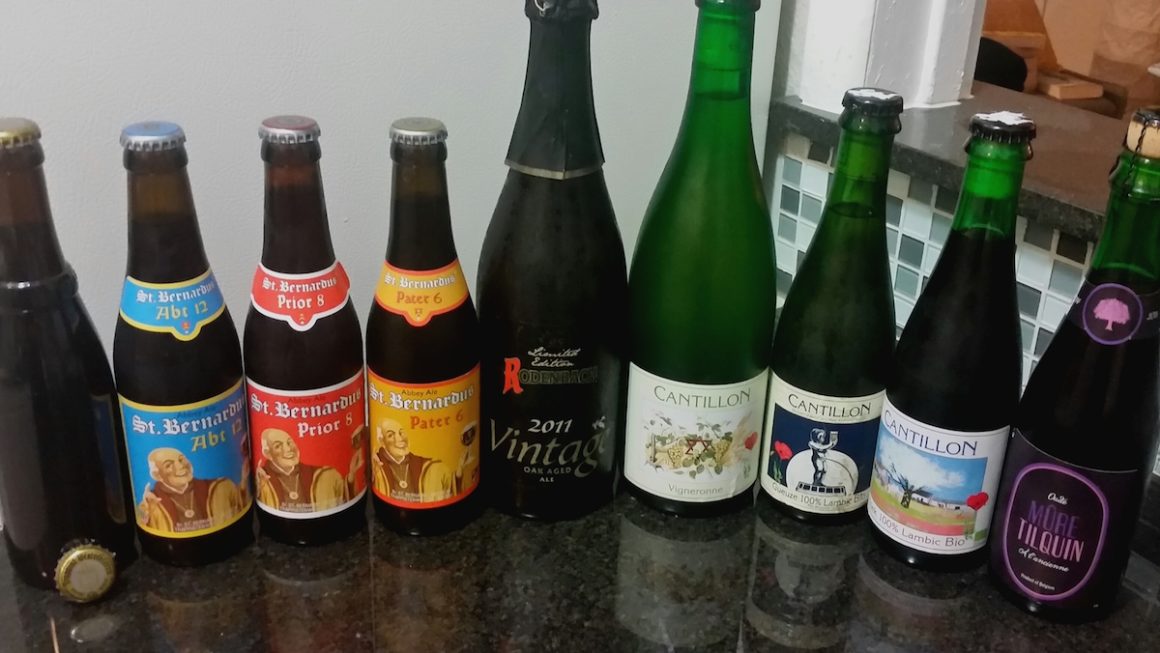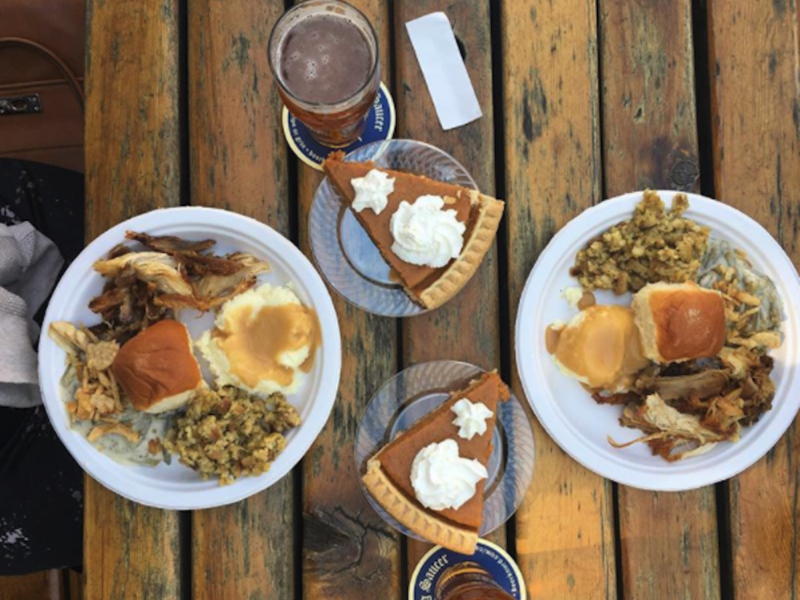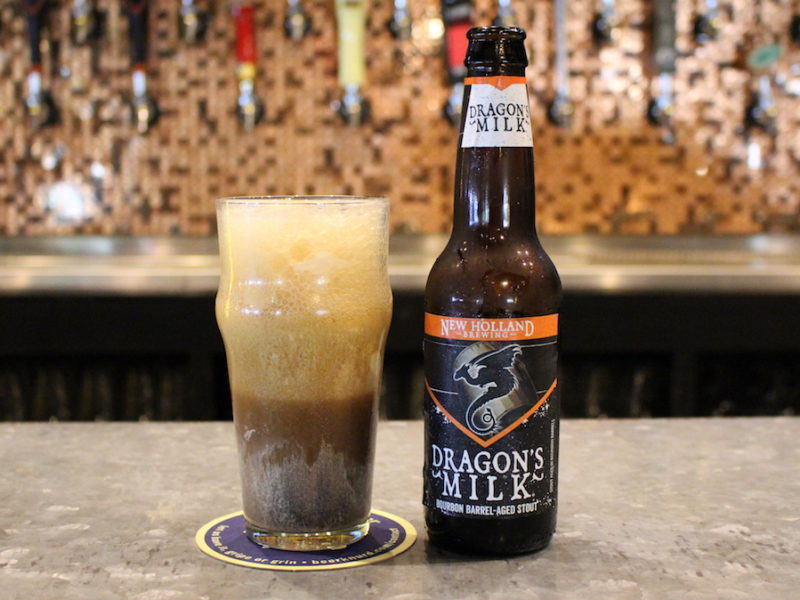In general, there are five Belgian beer styles: the mouth-puckering tart lambic, the pungent and acerbic oud bruin and Flanders red ales, the smooth and yeasty abbey ales, refreshing farmhouse ales and the beer style that almost went extinct the Belgian witbier. Here’s what you need to know about each one before you take a sip.
What are the major Belgian beer styles?
Lambic/Gueuze
Lambics are spontaneously fermented beers brewed in western Belgium. After the unfermented beer, aka the wort, has been through the mashing and boiling process, it’s then cooled and left to sit in a coolship, where it gathers wild yeast and bacteria to ferment into beer. No commercial yeast is added and because of this, nowhere else in the world brews true lambics because the exact breed of microfauna doesn’t exist in any other environment. The wild yeast and bacteria give it a clean tart flavor, and the beer is usually blended with older and younger vintages, as well as various fruits, to create different variations.
Probably the most popular lambic brewer in the world is Brouwerij Cantillon. Its most common beer, Cantillon Gueuze, is a blend of one-, two- and three-year-old beer from oak barrels, which is then bottle-conditioned another year to achieve optimal flavor and carbonation. A master blender will usually taste 10 different barrels before finally choosing five or six with which to blend. The folks at Brouwerij Cantillon have been brewing the same way since they opened in 1900. They’re known to add local fruits and other ingredients to create a variety of blended variations of the classic Cantillon Gueuze, including:
- Apricot: Fou’Foune
- Cherry: Kriek
- Raspberry: Rosé de Gambrinus
- Muscat grapes: Vigneronne
- Merlot and Cabernet-Franc grapes: St. Lamvinus
- Dry-hopped with Saaz: Iris
- Wine barrel: Lou Pepe variations
There are many breweries in the United States successfully making lambic-style beers, including Allagash’s Resurgam, Russian River’s Supplication and Jester King’s wide assortment of fruited wild-fermented beers such as its Atrial Rubicite. Drie Fonteinen, Tilquin and Boon are other popular Belgian lambic and gueuze breweries.
Oud Bruin/Flanders Red Ale
Oud bruins (also known as the East Flanders brown ale) and the Flanders red ale are two similar styles of beer brewed in the Flanders region of Belgium. Unlike the lambic, these two styles are dark in color and take on more of a sour taste. They’re not spontaneously fermented, opting for more controlled fermentation to create their unique flavors. They can range from sugary SweeTARTS to bold, sour, almost vinegar-like flavors, depending on age and blending ratios. Outside of their slightly different hues and subtle variations in flavor, the only real difference between the two styles is that the mixed bacteria culture and yeast are added during primary fermentation only for the oud bruin.
Brouwerij Rodenbach is the grandfather of the oud bruin and is probably the most internationally renowned for brewing it as well. You can find its Rodenbach Original almost anywhere in Belgium for pretty cheap. Rodenbach Original is a blend of 25 percent aged beer (more than a year old) and 75 percent young beer (less than a year old). The more flavorful Rodenbach Grand Cru is 67 percent aged beer and 33 percent young beer and comes across more sour and wine-like. Brouwerij Liefmans is also credited with popularizing the oud bruin through its Goudenband brand.
Duchesse de Bourgogne from Brouwerij Verhaeghe, a Flanders red, and the Petrus oud bruin are other Belgian-brewed styles easily found in the United States, in addition to New Belgium’s oud bruin, La Folie.
Abbey Ales (Blonde/Dubbel/Tripel/Quadrupel)
Belgian abbey ales are a subset of beers originally perfected by Belgian monks. The most famous of the beer-brewing monks are the Trappists. There are approximately 170 Trappist abbeys in existence, and only 11 of them brew beer. Six of those 11 reside in Belgium.
The most famous of those six is the St. Sixtus Abbey, brewers of the Westvleteren brand. In obedience to God and in accordance with their Cistercian Order, the monks brew only enough beer to support their way of life. At one point, the monks of St. Sixtus contracted their recipes out to St. Bernardus to make their beers on a commercial scale, but the agreement expired in 1992. St. Bernardus still makes wonderful abbey-style ales today but is no longer associated with the St. Sixtus monastery. The most admired of the abbey ales is the Westvleteren XII quadrupel (far left bottle in the picture above), brewed by the monks of St. Sixtus. The monastery also produces Westvleteren Extra VIII (an 8% Belgian dubbel), as well as an easy-to-drink Belgian blonde (a 6% Belgian pale ale).
These styles of beers are the most recognizable of the Belgian beers. They are best-known by their yeast characteristics: from the bubblegum and spicy notes in the lighter Belgian pale ales and tripels to the dark fruit and notes of brown candi sugari (crystalized inverted sugar syrup) in the darker dubbels and quadrupels.
While Westvleteren is not easily found in the United States, St. Bernardus Abt 12 and Rochefort 10 are similar to the Westvleteren XII, and both Delirium and Duvel brew fairly widespread Belgian pale ales similar to lighter Belgian blonde abbey ales. All are readily available in the United States, in addition to other Belgian Trappist breweries including Chimay, Westmalle and Orval.
Farmhouse Ales (Saison/Biere de Garde)
The saison, French for “season,” was invented to be a refreshing low-alcohol beer for workers to drink during the winter months in the southern Wallonia region of Belgium, where there wasn’t much to do on the farms. In today’s beer scene, the farmhouse style is sometimes used as a blanket term for any kind of pale ale fermented with a Belgian-style or wild strain of yeast, typically about 6% ABV. It’s sometimes used to refer to American wild sour beers, and some will brew these beers up 10%. Though this may be the trend, the traditional Belgian saison should be light in color, easy to drink and refreshing, with little to no bitterness. Biere de gardes are very similar to saisons but tend to be more malt-forward and less fruity than their beer cousin. Translated to “beer for keeping,” biere de gardes were traditionally kept for the busier, warmer months, which were less conducive to brewing.
Saison Dupont is the most classic example of a saison: 6.5% ABV, light color, spice and citrus fruitiness from the yeast and dry hay-like taste. Brewery Ommegang, a well-known American brewery from Cooperstown, New York, specializing in Belgian-style beers, offers a year-round Hennepin Farmhouse Saison that can stand up to almost any traditional saison out there. Jolly Pumpkin from Dexter, Michigan, makes a handful of biere de gardes, including its Oro de Calabaza and Biere de Mars.
Witbier
What was previously almost extinct, the Belgian witbier was revived in the 1950s by Peter Celis in a beer that everyone knows today as Hoegaarden (now owned by AB-Inbev). The Belgian witbier is brewed with unmalted wheat, coriander and orange peel, is usually lower in alcohol and is light and refreshing. Many of the large-production brewers in the United States have latched onto this beer style, including Blue Moon (Miller Coors) and Shock Top (AB-InBev). Great craft options can be found in Allagash White, Dogfish Head’s Namaste and Avery’s White Rascal.
There are a few other Belgian beer styles out there such as the Belgian strong dark ales and Belgian strong pale ales, but they’re more general categories for beers that don’t fall under any of the other classifications mentioned above. For more details on Belgian beer styles (and many other styles), check out the Beer Judge Certification Program 2015 Style Guidelines.








